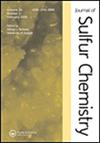The first type of binuclear copper complex with terminal sulfide: synthesis, structural characterization, and cytotoxicity evaluation
IF 1.6
3区 化学
Q3 CHEMISTRY, MULTIDISCIPLINARY
引用次数: 0
Abstract
A novel copper complex of [CuII (μ2–S)(terminal-S)(2-acetylpyrdine oxime)2 (1) is synthesized and characterized by X-ray single-crystal diffraction. The free ligand of 2-acetylpyrdine oxime is an unexpected product obtained from a condensation reaction of p-aminobenzene sulfonamide and 2-acetylpyridine and is characterized by IR, 1HNMR, and 13CNMR spectroscopic methods. X-ray crystallography showed strictly planar bridged μ2- Cu2(S)2 core, and each copper(II) center exhibits distorted square pyramidal coordination geometry. The cytotoxicity of the complex was tested in vitro against esophageal cancer (SKGT-4) cell lines by metabolic tests, using 3-(4, 5-dimethylthiazol-2-yl)-2,5-diphenyl-tetrazolium bromide as a reagent. Complex 1 showed a remarkable inhibition response in SKGT-4 cell lines.
第一类末端硫化物双核铜配合物:合成、结构表征及细胞毒性评价
合成了一种新型铜配合物[CuII (μ2-S)(末端- s)(2-乙酰吡啶肟)2(1)],并用x射线单晶衍射对其进行了表征。2-乙酰吡啶肟的游离配体是对氨基苯磺酰胺与2-乙酰吡啶缩合反应的意外产物,并通过IR、1HNMR和13CNMR光谱方法进行了表征。x射线晶体学显示μ2- Cu2(S)2核心呈严格的平面桥接,各铜(II)中心呈畸变的方锥体配位几何。以3-(4,5 -二甲基噻唑-2-基)-2,5-二苯基溴化四氮唑为试剂,通过代谢试验检测了该复合物对食管癌(SKGT-4)细胞株的体外细胞毒性。复合物1在SKGT-4细胞系中表现出显著的抑制作用。
本文章由计算机程序翻译,如有差异,请以英文原文为准。
求助全文
约1分钟内获得全文
求助全文
来源期刊

Journal of Sulfur Chemistry
CHEMISTRY, MULTIDISCIPLINARY-
CiteScore
4.10
自引率
9.10%
发文量
38
审稿时长
6-12 weeks
期刊介绍:
The Journal of Sulfur Chemistry is an international journal for the dissemination of scientific results in the rapidly expanding realm of sulfur chemistry. The journal publishes high quality reviews, full papers and communications in the following areas: organic and inorganic chemistry, industrial chemistry, materials and polymer chemistry, biological chemistry and interdisciplinary studies directly related to sulfur science.
Papers outlining theoretical, physical, mechanistic or synthetic studies pertaining to sulfur chemistry are welcome. Hence the target audience is made up of academic and industrial chemists with peripheral or focused interests in sulfur chemistry. Manuscripts that truly define the aims of the journal include, but are not limited to, those that offer: a) innovative use of sulfur reagents; b) new synthetic approaches to sulfur-containing biomolecules, materials or organic and organometallic compounds; c) theoretical and physical studies that facilitate the understanding of sulfur structure, bonding or reactivity; d) catalytic, selective, synthetically useful or noteworthy transformations of sulfur containing molecules; e) industrial applications of sulfur chemistry; f) unique sulfur atom or molecule involvement in interfacial phenomena; g) descriptions of solid phase or combinatorial methods involving sulfur containing substrates. Submissions pertaining to related atoms such as selenium and tellurium are also welcome. Articles offering routine heterocycle formation through established reactions of sulfur containing substrates are outside the scope of the journal.
 求助内容:
求助内容: 应助结果提醒方式:
应助结果提醒方式:


